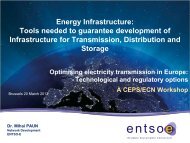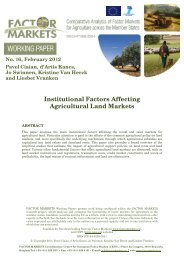Benchmark
Benchmark
Benchmark
Create successful ePaper yourself
Turn your PDF publications into a flip-book with our unique Google optimized e-Paper software.
CEPS <strong>Benchmark</strong>ing8 th July 2009Chris Beddoes
Some lessons from 25 years of Refiningbenchmarking• It takes time to develop confidence in the benchmarking output:– Tough to get the comparisons right first time.– Data consistency and integrity, eliminate gaming – Solomon has worked at theseissues.– Without confidence that a benchmark “ranking” reflects real performance, it willnot drive behaviour change.• Solomon based benchmarks have for many become part of “normalbusiness”:– Many Refineries have built their Solomon competitive positioning into theirinternal measurement processes..– Business decisions are based on this….investment, organisation etc– “You get what you measure”What started as a “ranking tool” has become for many an important driverfor change.3
A benchmark “ranking” thus complementsthe normal price signal?• All EU Refiners get very similar price signals:– Refined products are global commodities, so refinery energy prices are also verysimilar– Industry energy efficiency has improved, though individual refinery energy costsvary significantly.• Some Refiners also use their “competitive ranking” to drive improvement:– What are my absolute energy costs? Of course important.– But, also what is my ranking vs. competition?• Not a perfect reaction :– McKinsey highlighted some of the reasons, such as difficulties to buildawareness, balance conflicting demands on resources etc– Some of the changes require major capital, long planning, often extendedshutdowns.– Even then, some changes are just not feasible or economically viable.• But even on a voluntary basis a benchmark ranking can enhance the“simple” price signal to incentivise improvement.4
The fossil fuels challenge:Well to wheels CO2FOSSIL FUELSProduction in Europe covered by ETSCrude Production1 – 4 %Refining8 – 10 %Distribution & retail1%Combustion ofunit of energy85%Well-to-Tank 15%(production)Tank-to-Wheel 85%(consumption)EU Downstream 9-11%55Source: CONCAWE
Refineries need to convert some residue tolight products in order to keep marketssupplied21%7%NaphthaKeroseneNaphtha &Gasoline38%24%45%Diesel/GasoilResidueJet/KeroseneDiesel /GasoilFuel Oil11%33%18%Crude Oil6Market• The average yield obtained from crude oil distillation does not match the proportionof products demanded by the market• To rectify this refiners use different combinations of conversion and treatingprocesses to produce more lighter products from residue
The “hydroskimming” refinery upgradesnaphtha to gasoline and gasoil to dieseland heating oilRefinery FuelLPGrude OilNaphthaISOMERISATIONREFORMERGasolineDISTILLATIONHydrogenJet / KeroseneGasoilHYDROTREATERGasoil and DieselHeavy Fuel Oils7
Deep conversion refineries also convertvacuum residueRefinery Fuel and LPGISOM/REFORMERGasolineCrude OilDISTILLATIONHydrogenCRACKINGUNITHYDROTREATERGasoil anddieselVACUUMDISTILLATIONDEEPCONVERSIONHeavy fueloil8
How to compare ~110 EU Refineries, size from2-20MT, varied product outputs• Refining is a complex “co production” process: simplecrude or product based benchmarks do not adequatelyrepresent it.• Solomon CWT or “complexity weighted tonne” representsthe total “production” of a particular Refinery.– Although varied, some common product classes: LPG, naphtha,gasoline, kerosene, diesel/gasoil and heavy fuels.• “CWT” will characterise Refineries of different sizes andcomplexity as a simple means of comparing the emissionsfrom all the different Refineries.9
One parameter to characterise EU refining• A single, common “production” parameter CWT for all sites is a majorachievement:– Reviewed and endorsed by Concawe.– All EU Refineries included.– Applicable to all EU Refineries, across 27 EU Countries.– Takes into account the product mix produced by each Refinery.– Reduces competitive distortion and complexity of using severalparameters.• Ecofys May 19 th draft report on the Refinery Sector concludes:– “that the approach is suited to compare different refineries”– “is flexible enough to come to a benchmarking methodology in line with theDirective”• The same parameter can be used for New Entrants10
How to derive the average of the best10%: excluding the outliers by regression?Population ofRefineriesEmissions,Te CO 2 /CWT10 percentile114Average,Te CO2/CWT<strong>Benchmark</strong>:Here?Not Here?11Refinery CO2 benchmarking:Concawe – draft results
BACK UP
Application issues• Competitive impacts:– <strong>Benchmark</strong>ing must target real performance and not distort competitionin a sector.– Concawe-Solomon approach has this as a key success factor.• Encourage greater reductions?– There is still a carbon value even for those better than benchmark.– But an over aggressive benchmark will severely penalise someinstallations and not necessarily incentivise others.• Verification:– Looking for perfection or just obvious signs of problems?– Once off, ex ante exercise – encourage sector involvement to “selfpolice”– Pragmatic, work with Csion and MSs.13
Refining is an energy intensive industry:Energy is its biggest cost: 60% of operating cost$/bbl100Crude cost and Income from products806040200Product incomeCrude cost$/bbl8.06.04.02.0Refinery operating cost 2007RefiningenergycostOtheroperating costsCO 2 cost@ €30/TeSources:-Price: Platts- Typical refinery yield: ConcaweSources:- Operating cost:ConcaweHydrocarbonMarginNetMarginNet Marginless CO 2cost14
Improvements in energy efficiency do not match theincreased energy required for more complexrefineries•EU refineries energy intensity and-13 %•94•92•specific consumption•6.4%•Energy Intensity Index•90•88•86•84•82•80•% of feed•Energy Intensity index•6.2%•6.0%•5.8%•5.6%•Specific energy consumption•(% of feed)•78•1990 •1992 •1994 •1996 •1998 •2000 •2002 •2004•5.4%1515•Source: Solomon Associates
Recommended ground-rules forbenchmarking as part of EU ETS• Do not damage competitiveness of EU versus other regions:– Whilst still stimulating emissions reductions.• Equitable treatment of all sectors “exposed to significant risk”– Directive does not differentiate between exposed sectors.– Sector benchmarks should require similar effort.• Equitable treatment of all installations within a sector:– Financial stakes are high.– Must not distort competition within a sector.– Allows differentiation between installations on CO2 efficiency – rewards earlymovers.• Be sufficiently transparent to:– Allow someone with reasonable technical knowledge (but not necessarilysector specific) to understand.• Be applicable in practice:– Fit for purpose for the sector concerned: one size will not fit all.– “Ex ante” benchmarks based on single reference period to give predictabilityfor business decisions.– Be verifiable.16
What are the specific factors to considerwhen characterising Refining?• Refining is a “co production” process:– Typical production includes LPG, naphtha, gasoline, kerosene,diesel/gasoil and fuel oil.– Yields of each product vary between refineries, but not possible to producejust one or two products.– Not possible to allocate CO2 by product.• Broad range of size and degree of upgrading:– EU refineries range from 2 to 20 MTe per year in production.– Although almost all Refineries start with Crude Distillation, each individualrefinery has a different combination of units and technology to produce itsown final product mix.• A Refinery total energy use and therefore emissions are not simply the“sum of the parts”:– Combining or heat integrating units optimises energy use and reducesemissions.– Energy typically represents over 50% of Refining cost, so most sites havemade major steps in this optimisation.• The methodology should ideally reflect these factors:– Characterise emissions from all Refineries with multi product mixes.17
Setting the “benchmark” for an EII sector:when should it apply?CO2 allowances (MTe)Step reductionin 2013 forexclusion ofelectricityproduced bythe sectorIs thebenchmarkapplicableimmediately inone step in2013?Or in 2020, with agradual declinefrom 2013 in linewith EUprogressive Capreduction to 2020?2005 2008 2013 2020PHASE 1 PHASE 2 18PHASE 3
Complexity Weighted Tonne, or CWT:the essential elements“CWT” is a relatively simple way of characterising the CO2emissions from Refineries of different sizes andcomplexity:• A list of generic process units is defined, applicable to all Refineries.• Each process unit is assigned an emission factor representative of itspropensity to emit CO2 relative to crude distillation at standard energyefficiency and fuel emission factors• A standard process emissions term is added where relevant. E.g.FCC, hydrogen production, coker.• For each process unit the emission factor is multiplied by itsthroughput and these are totalled up.• An allowance is added for off-sites e.g. tankage, jetty facilities• The final metric is corrected to account for the import and export ofenergy, in particular power and steam.19
A single throughput parameter whichcompares Refineries’ CO2 efficiency.CO 2 emissions TeAbove line:more CO2/CWTXXXXXXBelow line:less CO2/CWTXXX represents actualemissions for arefinery. All points arenot on the linebecause ofdifferences CO2efficiency (i.e. energyefficiency and fuelcarbon content)Capacity factor “Complexity Weighted Tonne” or CWTRefinery CO2 benchmarking:Concawe – draft results20
Preliminary conclusions• The parameter works well for the entire population of EU Refining:– Refineries of all sizes and complexity appear well distributed along the curve(*)One single parameter can be used• Difference between actual performance of a Refinery and the correlation isdue to energy efficiency or fuel carbon content:– If corrected for actual CO2 efficiency (energy efficiency and fuel carboncontent) Refinery CO2 emissions correlate closely with CWT (>99%)– Has been tested using Solomon extensive energy and fuel database.– There is a wide range of actual CO2 emissions per CWT in the EU population. Will provide differential incentive and incentivise emissionsreductions.• The methodology can be used for New Entrants:– A CWT allowance can be defined for a plant expansion under the New Entrantprovisions.One single coherent system.(*) to be confirmed finally when all data available21








